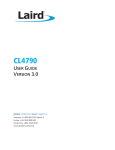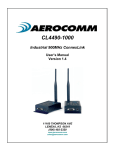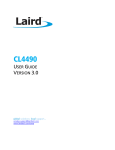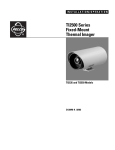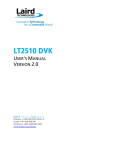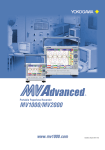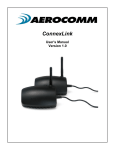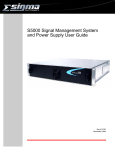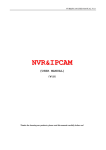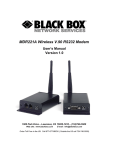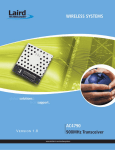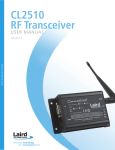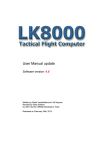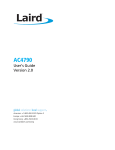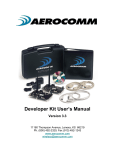Download CL4790 Manual - Digi-Key
Transcript
CL4790 Industrial 900MHz ConnexLink User’s Manual Version 1.0 11160 THOMPSON AVENUE LENEXA, KS 66215 (800) 492-2320 www.aerocomm.com [email protected] Document Information Copyright Information Copyright © 2004 AEROCOMM, Inc. All rights reserved. The information contained in this manual and the accompanying software programs are copyrighted and all rights are reserved by AEROCOMM, Inc. AEROCOMM, Inc. reserves the right to make periodic modifications of this product without obligation to notify any person or entity of such revision. Copying, duplicating, selling, or otherwise distributing any part of this product without the prior consent of an authorized representative of AEROCOMM, Inc. is prohibited. All brands and product names in this publication are registered trademarks or trademarks of their respective holders. This material is preliminary Information furnished by AEROCOMM in this specification is believed to be accurate. Devices sold by AEROCOMM are covered by the warranty and patent indemnification provisions appearing in its Terms of Sale only. AEROCOMM makes no warranty, express, statutory, and implied or by description, regarding the information set forth herein. AEROCOMM reserves the right to change specifications at any time and without notice. AEROCOMM products are intended for use in normal commercial applications. Applications requiring extended temperature range or unusual environmental requirements such as military, medical life-support or life-sustaining equipment are specifically not recommended without additional testing for such application. Limited Warranty For a period of one (1) year from the date of purchase, AEROCOMM warrants the transceiver against defects in materials and workmanship. AEROCOMM will not honor this warranty (and this warranty will be automatically void) if there has been any: (1) Tampering, signs of tampering, or opening the transceiver’s case. (2) Use of AC power adapters and cables other than those originally supplied with the transceivers. (3) Repair or attempt to repair by anyone other than an AEROCOMM authorized technician. This warranty does not cover and AEROCOMM will not be liable for, any damage or failure caused by misuse, abuse, acts of God, accidents, electrical irregularity, or other causes beyond AEROCOMM control, or claim by other than the original purchaser. 6/24/2005 2 FCC Information FCC Notice WARNING: This device complies with Part 15 of the FCC Rules. Operation is subject to the following two conditions: (1) This device may not cause harmful interference and (2) This device must accept any interference received, including interference that may cause undesired operation. RF Exposure/Installation Instructions WARNING: To satisfy FCC RF exposure requirements for mobile transmitting devices, this equipment must be professionally installed such that the end user is prevented from replacing the antenna with a non-approved antenna. The end user should also be prevented from being within 20cm of the antenna during normal use with the exception of hands, feet, wrists and ankles. The preceding statement must be included as a CAUTION statement in manuals for OEM products to alert users on FCC RF Exposure compliance. Caution: Any change or modification not expressly approved by AeroComm could void the user’s authority to operate the equipment. 6/24/2005 3 Table of Contents USER’S MANUAL ........................................................................................... 1 FIGURES .............................................................................................................................. 4 TABLES ................................................................................................................................ 4 1. CL4790 RF TRANSCEIVER....................................................................................... 5 1.1 1.2 1.3 2. OVERVIEW ........................................................................................................... 5 CL4790 SPECIFICATION ....................................................................................... 6 CL4790 INTERFACE ............................................................................................. 7 INTERFACING PROTOCOL .............................................................................. 10 2.1 2.2 2.3 RS-232............................................................................................................... 11 RS-485 (2-WIRE HALF DUPLEX) ........................................................................ 12 HARDWARE FLOW CONTROL ............................................................................. 13 3. NETWORK TOPOLOGIES..................................................................................... 14 3.1 POINT-TO-POINT ...................................................................................................... 14 3.2 POINT-TO-MULTIPOINT ............................................................................................ 14 4. CL4790/CN4790 CONFIGURATION UTILITY SOFTWARE............................. 15 4.1 INSTALLATION.......................................................................................................... 15 4.2 CL4790/CN4790 SETTINGS ..................................................................................... 15 4.2.1 CL4790 Settings ............................................................................................... 16 4.2.2 CN4790 Settings............................................................................................... 22 5. TROUBLESHOOTING ............................................................................................ 28 Figures Figure 1- RS-232/RS-485 CL4790 Front View.............................................................. 7 Figure 2- RS-232 CL4790 Back View ............................................................................ 8 Figure 3- RS-485 CL4790 Back View ............................................................................ 8 Figure 4- CL4790 Mechanical Diagram......................................................................... 9 Figure 5- RS-232 Male/Female Connector Pin out ................................................... 11 Figure 6- DCE to DTE Interface.................................................................................... 11 Figure 7- DCE to DCE Interface ................................................................................... 12 Figure 8- Point-to-Point Network.................................................................................. 14 Figure 9- Multiple Networks of Point-to-Multipoint CL4790s ................................... 14 Tables Table 1 – DTE, DCE and Null Modem Signal Definitions......................................... 10 6/24/2005 4 CL4790 User’s Manual 1. CL4790 RF Transceiver The CL4790 transceiver is a Frequency-Hopping Spread Spectrum (FHSS) radio designed for license-free operation in the 900MHz ISM band. Out-of-the box, the radio sustains a standard asynchronous serial data stream between two or more radios. Housed in a compact and rugged die-cast enclosure, the radio is equipped to replace thousands of meters of serial cable with its wireless link. The radio features an RS-232 or RS-485 interface for integration into legacy data systems. Features Masterless: True peer-to-peer, each module can communicate with any other module within its range. API commands to control packet routing and acknowledgement on a packet-by-packet basis 1.1 Durable Industrial grade enclosure Transparent operation, supports any legacy system Transmits around corners, through walls Reliable communication up to 115.2Kbps Point-to-Point and Point-to-Multipoint setups Overview The CL4790 uses Frequency Hopping Spread Spectrum modulation, where the units “hop” from frequency to frequency many times per second using a specific hop pattern applied to all the transceivers in the same network. A distinct hopping pattern is provided for each Channel Number, thereby allowing multiple networks to co-exist in the same area without interference. CL4790 transceivers operate in a Masterless architecture. The unique feature of this architecture is its dynamic Session extension and Collision Avoidance mechanism, which uses a proprietary scoring system to promote contention free communication and ensure that each node has fair access to the network. This instinctive dynamic peer-to-peer networking architecture enables several transceiver pairs to carry on simultaneous conversations on the same network. CL4790s implement a proprietary communication protocol to provide secure data transmissions. As it uses FHSS technology, the data remains reliable over long distances. Use of license free frequency bands ensure that the units are ready to use with no further certification requirements. Each unit is small and easily portable for use in mobile and temporary settings as well as for fixed installations. The CL4790 configuration software enables custom configurations based on unique application requirements. 6/24/2005 5 CL4790 User’s Manual 1.2 CL4790 Specification Specifications CL4790 - 1000 TRANSCEIVER PERFORMANCE Output power 1000mW Transmission range Up to 1500 feet (450m) indoors; Up to 20 miles (32 km) line-of-sight Data rate Up to 115.2 Kbps RF Data Rate 76.8kbps fixed Receiver Sensitivity -100dBm typical @ 76.8kbps RF Data Rate Power Consumption (@ 12 Vdc) 400mA Configuration software Easy-to-use Windows based software NETWORKING AND SECURITY Frequency band, RF Technology 902 – 928, FHSS (USA); 915-928, FHSS (Australia) Supported Network Topologies Point-to-Point, Point-to-Multipoint Channels 32 Security One byte System ID. 56-bit DES encryption key. ANTENNA RF Connector RPSMA Jack Type 1/2 Wave Dipole ELECTRICAL Electrical requirements Line voltage 100 – 120V (240V outside US); Power supply 6-foot cable, AC power connector ENVIRONMENTAL Environmental conditions Operating temperature -40° to +80°C; 10% to 90% humidity (non-condensing) PHYSICAL Dimensions 4.4 x 2.7 x 1.4 inches Weight 6 oz (170 g) Serial Connector DB-9 Male (RS-232), Terminal Block (RS-485) Serial Cord length 6 feet (183 cm) 6/24/2005 6 CL4790 User’s Manual 1.3 CL4790 Interface The CL4790 supports RS-232/RS-485 (2-wire Half Duplex) protocols. By definition, RS-485 protocol can tolerate high noise and push signals over long cable lengths. When using cables, RS-485 will communicate as far as 4000feet (1200m) and offer multi-drop capability where up to 32 nodes may be connected. RS-232 cables are suitable for distances less than 100 feet (30.5m). AeroComm wireless solutions are not subject to the cabling restrictions for distance, but either interface (RS-232 or RS-485) is available when ordering the CL4790s. Figure 1- RS-232/RS-485 CL4790 Front View Status LEDs Pwr Link Rx RPSMA Antenna Connector Tx CL4790 Status LEDs LED Color Pwr Green Link Red Rx Green Tx Red 6/24/2005 Description On indicates that the unit is powered up. On indicates the transceiver units are in range of one another. When flashing, LED indicates CL4490 unit is receiving data. When and flashing, LED indicates CL4490 unit is sending data. 7 CL4790 User’s Manual RS-232 Pin Assignments Figure 2- RS-232 CL4790 Back View DB9 Male Connector 1 Power Connector Pin 1 2 3 4 5 6 7 8 9 5 6 9 Description DCD TxD RxD DSR GND DTR CTS RTS RI RS-485 (2-wire Half Duplex) Terminal Block Pin Assignments Figure 3- RS-485 CL4790 Back View Terminal Block Power Connector 1 6 Pin Description 1 VCC (6V-18V)(1.3 A Required) 2 485- (485B) 3 No Connect 4 No Connect 5 485+ (485A) 6 GND Note: Standard power is applied through the power connector. Alternative power is available via the terminal block pins. 6/24/2005 8 CL4790 User’s Manual CL4790 Mechanical Diagram Figure 4- CL4790 Mechanical Diagram 1.170 Antenna Connector SMA Jack, Reverse Polarity 0.538 0.536 0.060 0.000 Side View Label Recess, 3.5w x 2.0h 0.150 dia. mounting holes (4) places 2.750 2.375 2.000 J3 9 Pin Male D-Connector Tx Status LEDs J4 Pwr Link Rx Power Jack w/ 0.100 dia. pin and 0.250 opening, pin is PWR. 0.375 0.000 4.750 4.500 4.185 0.565 0.250 0.000 Top View Note: All dimension in inches unless noted 6/24/2005 9 CL4790 User’s Manual 2. Interfacing Protocol The CL4790 is a DCE (Data Communications Equipment). A DCE can be interfaced to a DTE using a straight through serial cable (the serial cable provided with the CL4790 is a straight through cable). Typically, PC’s are defined as a DTE and peripherals are defined as DCE. To interface a DCE with another DCE, or a DTE with another DTE, a null modem (or a Crossover) cable is required. The null modem simply swaps pins to convert a DCE to a DTE and vice-versa. A null modem cable can be provided with the CL4790 on request. The CL4790 transceivers support the following interface protocols • RS-232 • RS-485 (2-wire) Half Duplex Table 1 – DTE, DCE and Null Modem Signal Definitions DCE Pin DCE Signal DCE Number Name Direction DTE Pin Number DTE Signal Name DTE Null Modem Null Modem Direction Female DB9 Male DB9 1 DCD O 1 DCD I 1 NC 2 TXD O 2 RXD I 2 3 3 RXD I 3 TXD O 3 2 4 DTR I 4 DTR O 4 6 5 GND 5 GND 5 5 6 DSR O 6 DSR I 6 4 7 RTS I 7 RTS O 7 8 8 CTS O 8 CTS I 8 7 9 RI O 9 RI I 9 NC 6/24/2005 10 CL4790 User’s Manual 2.1 RS-232 RS-232 is a single ended data transmission protocol. The RS-232 signals are represented by voltage levels with respect to a system common (power / logic ground). The "idle" state (MARK) has the signal level negative with respect to common, and the "active" state (SPACE) has the signal level positive with respect to common. RS-232 has numerous handshaking lines (primarily used with modems), and also specifies a communications protocol. Figure 5- RS-232 Male/Female Connector Pin out RS-232 DB9 Female Connector RS-232 DB9 Male Connector Pin 1 2 3 4 5 6 7 8 9 Pin NC 2 3 4 5 6 7 8 NC Description DCD RxD TxD DTR GND DSR RTS CTS RI Description DCD TxD RxD DSR GND DTR CTS RTS RI Figure 6- DCE to DTE Interface CL4790 Modem OEM Host/PC CTS CTS RTS RTS RXD TXD TXD RXD GND GND DCD DCD DSR DSR DTR DTR DCE DTE Straight Through Cable 6/24/2005 11 CL4790 User’s Manual Figure 7- DCE to DCE Interface CL4790 Modem OEM Host CTS CTS RTS RTS RXD TXD TXD RXD GND GND DCD NC NC DCD DSR DSR DTR DTR RI NC NC RI DCE DCE Crossover Cable Note: The Straight Through Cable provided with the CL4790 has female connectors on both ends and the Crossover cable has a male connector at one end and a female connector at the other end. Please use a male-to-male adapter or female-to-female adapter wherever required. Using a null modem adapter with a Crossover cable is equivalent to using a Straight Through cable. 2.2 RS-485 (2-wire Half Duplex) The RS-485 interface uses a Differential Data Transmission that can help nullify the effects of ground shifts and induced noise signals that can appear as common mode voltages on a network. The CL4790 implements a RS-485 (2-wire Half Duplex) multi-drop interface. Typically, a RS-485 bus will consist of a master and several slaves. The nodes will have unique addresses and can send addressed packets to specific nodes. Because the bus is half duplex, no two nodes should try to talk at the same time. The CL4790 does not have a RS-485 address, therefore, it will transmit all RS-485 traffic over the RF. Conversely, as soon as a CL4790 receives a packet over the RF, it will transmit the packet over the RS-485 bus. Note: When using RS-485 (2-wire Half Duplex), a RS-485 to RS-232 converter is required to configure the unit. AeroComm recommends a B&B Electronics 4WSD9R converter to translate RS-485 to RS-232. 6/24/2005 12 CL4790 User’s Manual 2.3 Hardware Flow Control Flow control refers to the control of data flow between the host and the CL4790. It is the method used to handle data in the transmit/receive buffer of the CL4790 interface, and determines how data flow between the host and the CL4790 is throttled. Often, in serial communication, one device is capable of sending data much faster than the other can receive. Flow control allows the slower device to tell the faster device to pause and resume data transmission. (Flow control CTS and RTS are used by the CL4790 and its Host, locally – NOT over the air. Therefore, one CL4790 cannot tell the other to slow down or speed up as is mentioned above in the paragraph.) When the RTS Enable option is selected on the Configuration Utility, the transceivers use hardware flow control to regulate data flow. While using hardware flow control, the transceiver that is ready to receive data sends a Clear To Send signal to its host (or the device it is connected to). On the other hand, when a transceiver has something it wants to send to its host, it checks the state of Ready To Send and if it is logic low, will send data to its host. If RTS is logic high, it will not send data to its host. These signals are sent apart from the data itself on separate wires. Note: CTS is always enabled by default. RS-485 Interface does not support Hardware flow control. 6/24/2005 13 CL4790 User’s Manual 3. Network Topologies Topology refers to the shape of a network, or the network's layout. How different nodes in a network are connected to each other and how they communicate, is determined by the network's topology. The CL4790s support a Point-to-Point and a Point-to-Multipoint network topology. 3.1 Point-to-Point A point-to-point system is a simple arrangement consisting of just two CL4790s. Sometimes referred to as a wireless bridge, a point-to-point link replaces a single communications cable. A point-to-point link might be used to connect a PLC to a remote monitoring station. Figure 8- Point-to-Point Network OEM HOST (Remote Monitoring Station) CL4790 CL4790 OEM HOST (PLC) 3.2 Point-to-Multipoint Point-to-Multipoint systems have one base station, or access point, that controls communications with all of the other wireless nodes in the network. This allows for the creation of a wireless network consisting of multiple nodes. By programming each CL4790 with a network specific Channel Number and System ID multiple networks can be created see (Fig 9). Figure 9- Multiple Networks of Point-to-Multipoint CL4790s Example: Channel Number = 13 System ID = 123 6/24/2005 Example: Channel Number = 25 System ID = 256 14 CL4790 User’s Manual 4. CL4790/CN4790 Configuration Utility Software AeroComm provides the easy to use CL4790/CN4790 Utility Software for programming the CL4790/CN4790. The GUI based software does not require any hardware configuration and works by itself. The software is compatible with Microsoft® Windows 95, 98, 2000, Me, NT and XP. CL4790/CN4790s are plug-and-play devices that work with minimal or no configuration. However, users may refer to the AC4790 manual for details about the radio’s operation and advanced configuration commands. The SDK Software can be used to evaluate the advanced configuration commands. The SDK Software and AC4790 manual can be found on the Connex Tools and Literature CD or on our website at http://www.aerocomm.com/. Note: The users should refer to the ConnexNet manual for details about the CN4790 interface. 4.1 Installation 1. Locate the CL4790 Configuration Utility, 900 MHz link in the Software section on the Connex Tools & Literature CD. This software is also available at http://www.aerocomm.com/Software/Driver_CL4790_900Mhz_v.1.zip. 2. When prompted, accept the default directory or change to the desired directory where the program files will be installed. 3. When finished, a window will be displayed indicating a successful installation. Select OK. 4.2 CL4790/CN4790 Settings The configuration utility can be used to configure both CL4790 and CN4790. The configuration utility defaults to CL4790 configuration when it is loaded; it can be used to configure the CN4790 by checking the CN4790 check box on the configuration page. 6/24/2005 15 CL4790 User’s Manual 4.2.1 CL4790 Settings The CL4790 Settings Page is shown below, as it will appear the first time the program is run. 4.2.1.1 ConnexLink Settings Interface Baud Rate: This defines the baud rate used for communicating with the CL4790 over the serial interface. The RF baud rate is fixed at 76.8 Kbps and is independent of the Interface Baud Rate. The default baud rate setting is 57600 bps unless the units have been pre-configured by AeroComm. The Interface Baud Rate setting of the CL4790 must match the Baud Rate setting of its host device. Random Back Off: Random BackOff determines the random amount of time a transceiver waits when a collision occurs before resending the packet again. The amount of randomness is controlled by this parameter. Channel Number: A number that designates an independent network of CL4790 units. Up to 32 independent networks can be created. The valid range of values for this field is 16 to 47. 6/24/2005 16 CL4790 User’s Manual Max Transmit Retries: This value represents the maximum number of times a particular data packet will be transmitted unsuccessfully, or without an acknowledgement, before the CL4790 discards the packet. The default value is 4 attempts. If communication is lost and the Link LED is on, try increasing this value in small increments until communication is reestablished. Note: This value is always associated to radios in Point to Point network. The valid range of values for this field is 2 to 255. Broadcast Attempts: This value represents the number of times a data packet will be transmitted by the CL4790 when in Broadcast mode. The default value is 4 attempts. If communication is lost and the receiving radio’s Link LED is on, try increasing this value in small increments until communication is reestablished. Note: This value is always associated to radios in Point-to-Multipoint network. The valid range of values for this field is 2 to 255. System Identification: A number from 0 to 256 that provides added security to each independent network of CL4790 units. The System ID is used in conjunction with the Channel Number and serves as an RF password to maintain secure transfers of data. The combination of the Channel Number and System ID must be unique to each network of CL4790s to establish communication. Multiple transceivers in the same coverage area must be programmed with different Channel Numbers to prevent inoperability of the networks. The System ID will not prevent inoperability that occurs from locating multiple transceivers with the same Channel Number in the same coverage area. Important Note: Separate Collocated CL4790 networks must operate on different Channel Numbers. All units in a given CL4790 network must have identical Channel Numbers and System IDs. Data Encryption Key: Encryption is the process of encoding an information bit stream to secure the data content. The DES algorithm is a common, simple and well-established encryption routine. An encryption key of 56 bits is used to encrypt the packet. The receiver must use the exact same key to decrypt the packet; otherwise garbled data will be produced. Destination Address: The MAC Address of the remote CL4790 in a Point-to-Point network. Used to optimize Point-to-Point communications by utilizing RF Acknowledgement. Firmware Version: Displays the CL4790’s firmware version. MAC Address: A unique 6 Byte, IEEE 802.3 Ethernet address assigned by AeroComm to each CL4790. 4.2.1.2 RF Delivery Broadcast: Enables Broadcast mode. When enabled, the transceiver will send its packets to all transceivers on that network. Auto Destination: Enables Auto Destination mode. When enabled, the transceiver sets its destination address to the address of the radio from which it received a packet first. Destination Address: Enables Addressed mode. When enabled, the transceiver can send or receive data from a transceiver specified by the Destination Address box in the ConnexLink Settings. 6/24/2005 17 CL4790 User’s Manual 4.2.1.3 Optional Settings Data Encryption: Enables the Data Encryption Key. All CL4790s in the same network must have the same encryption setting. RTS Enable: Enables the Request To Send control line. When enabled, enables Hardware Flow Control. Refer to Section 2.3 Hardware Flow Control. Parity: Needs to be enabled if host requires even or odd parity and 8 data bits. This is considered as 9-bit mode. Note: Enabling Parity cuts the overall throughput into half. Full Duplex: This mode the transceivers intelligently shares the bandwidth to enable Full Duplex. Though the RF hardware is still technically half duplex, it makes the transceiver seem full duplex. This can cause overall throughputs to be cut in half. Note: All transceivers on the same network must have the same setting for Full Duplex. Modem Mode: Full modem handshaking is supported by the transceivers when Modem Mode is enabled. Modem Mode is incompatible with RS-485Interface. Enables DCD, DTR, DSR and Ring Indicator control lines. Ignore Broadcast: When enabled, a transceiver ignores all the broadcast packet it receives. 4.2.1.4 API Mode API Control is a powerful feature that the Masterless Protocol offers. When enabled, the Transmit API, Send Data Complete and Receive API features provide dynamic packet routing and packet accounting ability to the OEM Host, thereby eliminating the need for extensive programming on the OEM Host side. This ability of the protocol makes it ideal for any legacy system. Transmit API When Transmit API is enabled, the OEM Host should use the following format to transmit a packet over the RF. 81h Payload Data Length Session Count (1- 80h) Refresh Transmit Destination Retries/Broadcast MAC (2,1,0) Attempts Payload Data 1) If the OEM Host does not encode the header correctly, the transceiver will send the entire string (up to 80h bytes) and will look for the header in the next data. 2) Although the 7 bytes of overhead are not sent over the RF, they are kept in the buffer until the packet is sent. Keep this in mind so as to not overrun the 256byte buffer. 3) Setting MAC to FFh FFh FFh will broadcast the packets. 6/24/2005 18 CL4790 User’s Manual Consider the example of a remote temperature monitoring system where temperature readings are obtained from sensors attached to the transceivers at remote locations. This application may require polling each and every transceiver individually and obtaining the temperature reading. When the Transmit API is enabled the packets are dynamically routed with out requiring any configuration i.e. change the destination address every time the packet is transmitted. This makes it easy when hundreds of transceivers need to be polled. Send Data Complete When Send Data Complete is enabled, the transceiver sends the OEM Host the following data upon receiving an RF Acknowledge from the remote transceiver or exhausting all attempts. 00h: Failure 82h RSSI RSSI * 01h: Success 1) The RSSI is how strong the remote transceiver heard the local transceiver, RSSI* is how strong the local transceiver heard the remote transceiver. 2) Successful RF Acknowledge updates the Success/Failure bit. 3) When the transceiver is transmitting Broadcast Packets it will always return success after exhausting all Broadcast Attempts. 4) API Send Data Complete can be used as a software send data complete indicator 5) The transceiver could receive a failure even though the packet was received as it could have missed the RF Acknowledge from the remote transceiver. When the Send Data Complete is enabled an RF Acknowledge is received for every packet that has been transmitted. This would be very useful in cases where the information sent is vital and OEM Host needs to retry and send the message again in case of a failure. Receive API When Receive API is enabled; upon receiving a packet the radio sends its OEM Host the packet in the following format. 81h Payload Data Length RSSI RSSI* Destination MAC (2,1,0) Payload Data The RSSI is how strong the remote transceiver heard the local transceiver, RSSI* is how strong the local transceiver heard the remote transceiver. 6/24/2005 19 CL4790 User’s Manual Consider a remote temperature monitoring system where the transceivers have to transmit their temperature reading periodically. When the Receive API is enabled every data packet received has also the information about the transceiver that transmitted the packet. This information is very useful in identifying the transceiver and analyzing its wireless link. The Transmit API, Send Data Complete and Receive API can be used in any combination to suit different applications. OEM Host OEM Host Send Data Complete Receive API packet Transmit API packet RF Transmit Packet Local Transceiver RF Acknowledge Remote Transceiver Note: When both Send Data Complete and Receive API on the API Mode is enabled Send Data Complete is to be received before the transceiver gets a Receive API packet (i.e. receives another packet before it gets an acknowledge for a packet sent). However this order may get reversed when the Send Data Complete packet is missed and is being resent after the Receive API packet is received. Note: The API Mode over writes all the RF Delivery settings. 4.2.1.5 PC Settings Port: Serial communications port of the PC connected to the CL4790 unit. Baud Rate: Must equal the Interface Baud Rate setting of the CL4790 unit that is about to be programmed. 6/24/2005 20 CL4790 User’s Manual 4.2.1.6 Programming the CL4790 units 1. Connect a CL4790 unit to the serial communications port on the PC. 2. Connect the power supply to the CL4790 unit. Make sure the Pwr LED is on. 3. Start the CL4790 Configuration Utility. 4. Select the COM Port that is connected to the CL4790 unit on the PC Settings section. 5. Select the Interface Baud Rate of the CL4790 unit. All CL4790 units are shipped with a default rate of 57600 (unless units have been pre-configured to match specific serial settings). If the Interface Baud Rate of the CL4790 unit is changed as described in Section 4.2 Changing CL4790 Settings, then PC Setting Baud Rate must be set to the same Baud Rate to allow proper programming of the units. 6. Select Read Radio to display the current settings of the CL4790 unit. 7. Change desired settings. 8. After all changes have been made, select Write Radio to save the changes. 9. Cycle Power to the unit after all changes has been saved. This will set the CL4790 unit to its normal mode of operation. 6/24/2005 21 CL4790 User’s Manual 4.2.2 CN4790 Settings The CN4790 Settings Page is shown below, as it will appear the first time the CN4790 check box is checked. 4.2.2.1 ConnexLink Settings Random Back Off: Random BackOff determines the random amount of time a transceiver waits when a collision occurs before resending the packet again. The amount of randomness is controlled by this parameter. Channel Number: A number that designates an independent network of CN4790 units. Up to 32 independent networks can be created. The valid range of values for this field is 16 to 47. Max Transmit Retries: This value represents the maximum number of times a particular data packet will be transmitted unsuccessfully, or without an acknowledgement, before the CN4790 discards the packet. The default value is 4 attempts. If communication is lost and the Link LED is on, try increasing this value in small increments until communication is reestablished. Note: This value is always associated to radios in Point to Point network. The valid range of values for this field is 2 to 255. 6/24/2005 22 CL4790 User’s Manual Broadcast Attempts: This value represents the number of times a data packet will be transmitted by the CN4790 when in Broadcast mode. The default value is 4 attempts. If communication is lost and the receiving radio’s Link LED is on, try increasing this value in small increments until communication is reestablished. Note: This value is always associated to radios in Point-to-Multipoint network. The valid range of values for this field is 2 to 255. System Identification: A number from 0 to 256 that provides added security to each independent network of CN4790 units. The System ID is used in conjunction with the Channel Number and serves as an RF password to maintain secure transfers of data. The combination of the Channel Number and System ID must be unique to each network of CN4790s to establish communication. Multiple transceivers in the same coverage area must be programmed with different Channel Numbers to prevent inoperability of the networks. The System ID will not prevent inoperability that occurs from locating multiple transceivers with the same Channel Number in the same coverage area. Important Note: Separate Collocated CN4790 networks must operate on different Channel Numbers. All units in a given CN4790 network must have identical Channel Numbers and System IDs. Data Encryption Key: Encryption is the process of encoding an information bit stream to secure the data content. The DES algorithm is a common, simple and well-established encryption routine. An encryption key of 56 bits is used to encrypt the packet. The receiver must use the exact same key to decrypt the packet; otherwise garbled data will be produced. Destination Address: The MAC Address of the remote CN4790 in a Point-to-Point network. Used to optimize Point-to-Point communications by utilizing RF Acknowledgement. Firmware Version: Displays the CN4790’s firmware version. MAC Address: A unique 6 Byte, IEEE 802.3 Ethernet address assigned by AeroComm to each CN4790. 4.2.2.2 RF Delivery Broadcast: Enables Broadcast mode. When enabled, the transceiver will send its packets to all transceivers on that network. Auto Destination: Enables Auto Destination mode. When enabled, the transceiver sets its destination address to the address of the radio from which it received a packet first. Destination Address: Enables Addressed mode. When enabled, the transceiver can send or receive data from a transceiver specified by the Destination Address box in the ConnexLink Settings. 6/24/2005 23 CL4790 User’s Manual 4.2.2.3 Optional Settings Data Encryption: Enables the Data Encryption Key. All CN4790s in the same network must have the same encryption setting. Parity: Needs to be enabled if host requires even or odd parity and 8 data bits. This is considered as 9-bit mode. Note: Enabling Parity cuts the overall throughput into half. Full Duplex: This mode the transceivers intelligently shares the bandwidth to enable Full Duplex. Though the RF hardware is still technically half duplex, it makes the transceiver seem full duplex. This can cause overall throughputs to be cut in half. Note: All transceivers on the same network must have the same setting for Full Duplex. Modem Mode: Full modem handshaking is supported by the transceivers when Modem Mode is enabled. Modem Mode is incompatible with RS-485Interface. Enables DCD, DTR, DSR and Ring Indicator control lines. Ignore Broadcast: When enabled, a transceiver ignores all the broadcast packet it receives. 4.2.2.4 API Mode API Control is a powerful feature that the Masterless Protocol offers. When enabled, the Transmit API, Send Data Complete and Receive API features provide dynamic packet routing and packet accounting ability to the OEM Host, thereby eliminating the need for extensive programming on the OEM Host side. This ability of the protocol makes it ideal for any legacy system. Transmit API When Transmit API is enabled, the OEM Host should use the following format to transmit a packet over the RF. 81h Payload Data Length Session Count (1- 80h) Refresh Transmit Destination Retries/Broadcast MAC (2,1,0) Attempts Payload Data 1) If the OEM Host does not encode the header correctly, the transceiver will send the entire string (up to 80h bytes) and will look for the header in the next data. 2) Although the 7 bytes of overhead are not sent over the RF, they are kept in the buffer until the packet is sent. Keep this in mind so as to not overrun the 256-byte buffer. 3) Setting MAC to FFh FFh FFh will broadcast the packets. 6/24/2005 24 CL4790 User’s Manual Consider the example of a remote temperature monitoring system where temperature readings are obtained from sensors attached to the transceivers at remote locations. This application may require polling each and every transceiver individually and obtaining the temperature reading. When the Transmit API is enabled the packets are dynamically routed with out requiring any configuration i.e. change the destination address every time the packet is transmitted. This makes it easy when hundreds of transceivers need to be polled. Send Data Complete When Send Data Complete is enabled, the transceiver sends the OEM Host the following data upon receiving an RF Acknowledge from the remote transceiver or exhausting all attempts. 00h: Failure 82h RSSI RSSI * 01h: Success 1) The RSSI is how strong the remote transceiver heard the local transceiver, RSSI* is how strong the local transceiver heard the remote transceiver. 2) Successful RF Acknowledge updates the Success/Failure bit. 3) When the transceiver is transmitting Broadcast Packets it will always return success after exhausting all Broadcast Attempts. 4) API Send Data Complete can be used as a software send data complete indicator 5) The transceiver could receive a failure even though the packet was received as it could have missed the RF Acknowledge from the remote transceiver. When the Send Data Complete is enabled an RF Acknowledge is received for every packet that has been transmitted. This would be very useful in cases where the information sent is vital and OEM Host needs to retry and send the message again in case of a failure. Receive API When Receive API is enabled; upon receiving a packet the radio sends its OEM Host the packet in the following format. 81h Payload Data Length RSSI RSSI* Destination MAC (2,1,0) Payload Data The RSSI is how strong the remote transceiver heard the local transceiver, RSSI* is how strong the local transceiver heard the remote transceiver. 6/24/2005 25 CL4790 User’s Manual Consider a remote temperature monitoring system where the transceivers have to transmit their temperature reading periodically. When the Receive API is enabled every data packet received has also the information about the transceiver that transmitted the packet. This information is very useful in identifying the transceiver and analyzing its wireless link. The Transmit API, Send Data Complete and Receive API can be used in any combination to suit different applications. OEM Host OEM Host Send Data Complete Receive API packet Transmit API packet RF Transmit Packet Local Transceiver RF Acknowledge Remote Transceiver Note: When both Send Data Complete and Receive API on the API Mode is enabled Send Data Complete is to be received before the transceiver gets a Receive API packet (i.e. receives another packet before it gets an acknowledge for a packet sent). However this order may get reversed when the Send Data Complete packet is missed and is being resent after the Receive API packet is received. Note: The API Mode over writes all the RF Delivery settings. 4.2.2.5 PC Settings IP Address: IP Address of the CN4490 unit. Port: Port number of the CN4490 unit, the Port number is always 2101. 6/24/2005 26 CL4790 User’s Manual 4.2.2.6 Programming the CN4790 units 1. Connect a CN4790 unit to the serial communications port on the PC. 2. Connect the power supply to the CN4790 unit. Make sure the Pwr LED is on. 3. Start the CN4790 Configuration Utility. 4. Select the COM Port that is connected to the CN4790 unit on the PC Settings section. 5. Select the Interface Baud Rate of the CN4790 unit. All CN4790 units are shipped with a default rate of 57600 (unless units have been pre-configured to match specific serial settings). If the Interface Baud Rate of the CN4790 unit is changed as described in Section 4.2 Changing CN4790 Settings, then PC Setting Baud Rate must be set to the same Baud Rate to allow proper programming of the units. 6. Select Read Radio to display the current settings of the CN4790 unit. 7. Change desired settings. 8. After all changes have been made, select Write Radio to save the changes. 9. Cycle Power to the unit after all changes has been saved. This will set the CN4790 unit to its normal mode of operation. 6/24/2005 27 CL4790 User’s Manual 5. Troubleshooting Solution Problem CL4790 Read Radio 1. Make sure the PC Settings are right. See Section displays error 4.2.3 PC Settings. message: “Radio not responding.” 2. Make sure the CL4790 unit uses the right serial cable. Refer to Section 2.1 RS-232. 3. If any other program that is using the same COM port as CL4790 is open, close that program and try to read the radio again. 4. Reset the radio by cycling power after each unsuccessful Read. CN4790 1. Make sure the PC Settings are right. See Section 7.2.3 PC Settings. 2. Make sure the CN4790 unit uses the right Ethernet cable. Refer to Section 2.2 LAN Port. 3. If any other program that is using the same LAN port as CN4790 is open, close that program and try to read the radio again. 4. Reset the radio by cycling power after each unsuccessful Read. Write Radio displays error message: “Radio not responding.” 1. Cycle power to the radio. 1. Cycle power to the radio. 2. Read the radio and make desired changes and then Write the radio. 2. Read the radio and make desired changes and then Write the radio. Garbled Data received. 1. Check Data Encryption Standard settings. 1. Check Data Encryption Standard settings. Client’s Link LED does not come on. 1. Make sure the unit is connected to power. 1. Make sure Server CN4790 unit is powered up. 2. Cycle power to the radio. Link LED is on, but data does not get transmitted or received. 2. Cycle power to the radio. 1. Make sure the CL4790 unit(s) is connected to the correct COM Port. 1. Make sure the CN4790 unit(s) IP Address is right. 2. Check the COM port settings for correct Baud Rate, Parity and either Hardware or No Flow Control. Units can have transmission errors with Flow Control set to Xon/Xoff. 2. Try increasing the Maximum Transmit Attempts (for Clients) and/or Broadcast Attempts (for Servers) values in small increments until communication is established. 3. Try increasing the Maximum Transmit Attempts (for Clients) and/or Broadcast Attempts (for Servers) values in small increments until communication is established. 4. Connect a Null Modem adapter between the Client and its host device. 5. Check the Destination Address setting. 3. Check the Destination Address setting. If these troubleshooting tips do not resolve the problem, please call our toll free number at (800) 492-2320, extension 207. Technical support hours are Monday through Friday, 8:00 am to 5:00 pm Central Standard Time. 6/24/2005 28




























